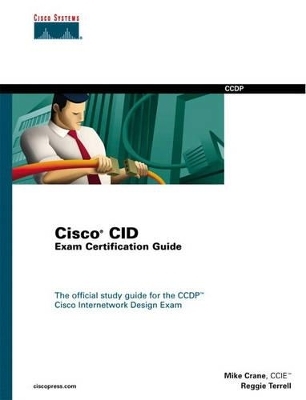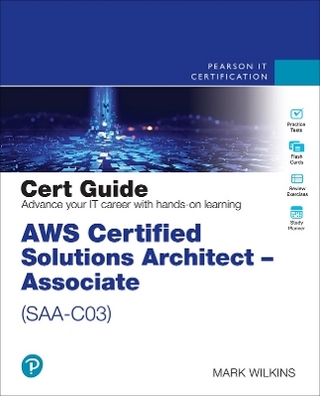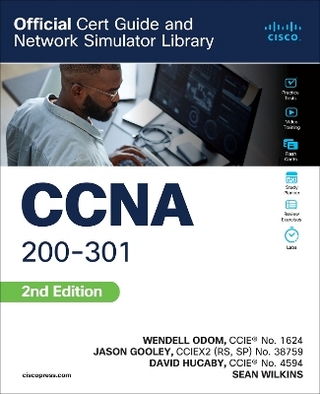
Cisco CID Exam Certification Guide
Cisco Press
978-1-58720-033-5 (ISBN)
- Titel ist leider vergriffen;
keine Neuauflage - Artikel merken
The only Cisco-approved study guide for the CCDP CID Exam.
The only Cisco-endorsed study guide for the Cisco Internetwork Design Exam.
Includes review of all concepts covered on the exam for designing complex routed and switched networks
Accompanying CD-ROM containing unique questions and sample tests to help readers identify and master areas of weakness
Extensive use of chapter quizzes and end-of-chapter questions
The only Cisco-endorsed study guide for the Cisco Internetwork Design Exam #640-025, Cisco CID Exam Certification Guide covers all of the major topic areas and objectives for the exam. Organized to help you make the most of your study time, this book focuses on review of the concepts involved in advanced network design, principles of network-layer including addressing, traffic management, and performance considerations.
Foundation Summary sections concisely outline major concepts for quick reference while chapter-opening quizzes enable you to evaluate your knowledge of chapter topics. Scenario-based exercises and chapter-ending review questions reinforce retention and recall of exam topics. Finally, practice questions on the companion CD-ROM enable you to build and take random sample tests.
Mike Crane, CCIE #5531, CCNP/DP, is currently employed with Timebridge Technologies as a Network Architect. Prior to Timebridge, Mike was a Senior Telecommunications Engineer where he designed a multiservice technologies network, which included IP/TV and Voice/IP/Frame using Cisco IP Phones. Mike has a vast amount of experience in the installation and design of local and wide area networks, installation and support of firewalls, routers, switches, CSU/DSUs, multiplexors, and various other equipment. Reggie Terrell, CCNP/DP, is currently employed with Science Applications International Corp. as a Senior Telecommunications Engineer, and is also the Enterprise Systems Engineer for System Source, a Cisco Premier Partner. Reggie has an A.A. in Engineering, a B.S. in Computer Science, and an M.S. in Telecommunications from the University of Maryland.
1. Design Overview.
Defining the Problem. Internetwork Design Goals. Seven Steps for Designing Internetworks. Cost Versus Availability. Concerns Facing Designers. Design Models. Hierarchical Design. Routers at Different Layers. Remote Access. Static and Snapshot Routing for Remote Access. Getting Information About Network Design.
2. Business and Technical Requirements.
Campus VLAN Design. Issues Facing Campus LAN Designers. Customer Availability Requirements. Selecting the Right Device.
3. Switched/Campus LAN Solutions.
Examining Campus LAN Technologies. Defining LAN Interconnection Methods. Cable Design Choices. Wireless Networks. LAN Switches. Deploying VLANs.
4. ATM Solutions.
ATM Protocols and Specifications. ATM Routing in Private Networks. ATM Design.
5. IP Addressing
TCP/IP Addressing. Prefix and Host Addressing. IP Network Classes. Classful and Classless Routing. Network Addressing Guidelines. Classless Interdomain Routing (CIDR). Route Summarization. Discontiguous Subnets. Subnetting. Calculating the Subnets and the Number of Hosts Per Subnet. Private Networks. Managing Addresses with DHCP. Multicast Routing.
6. IP Routing Concepts.
Static Versus Dynamic Routing. Types of Dynamic Routing Protocols. Switching and Path Determination. Path Determination. Categories of Routing Protocols. Decisions. Routing Convergence. Route Summarization. Route Redistribution. Route Redistribution Within the Same Network.
7. OSPF/EIGRP/IGRP.
OSPF Network Types. OSPF Classes of Routers. Link-State Advertisements (LSAs). Deciding on the Best Path. OSPF Summarization and Scalability. Security. Creating Neighbors. Designated and Backup Designated Routers. Stub Areas. Totally Stubby Area. Not-So-Stubby Areas (NSSAs). Determining OSPF Convergence. Load Balancing with OSPF. OSPF Backbone Design and Address Mapping: Area 0. Virtual Link. OSPF Area Addressing. Determining IGRP/EIGRP Routing, Characteristics, and Convergence. IGRP Features. IGRP Stability. Determining EIGRP Routing, Characteristics, and Convergence. Components of EIGRP.
8. AppleTalk.
Suite of Protocols. AppleTalk Addressing. AppleTalk Filtering Options. Configuring Cable Ranges. AppleTalk Routing Protocols. IPX Protocol and IPX Routing. Novell Routing. IPX SAP. NetWare Link-State Protocol. Windows Networking. Name Resolution. Scaling to Larger Networks. DHCP.
9. WAN Design Considerations.
Determining Which WAN Technology to Use. WAN Availability. Quality of Service (QoS) Networking. WAN Compression Techniques. Single-Protocol IP Backbone.
10. X.25/Frame Relay/ X.25/Frame Relay/X.25 Topologies.
X.25. Why Frame Relay? RFC 1490. Design Options. Hardware.
11. ISDN/PPP, Asynchronous Remote Access Remote Access.
Remote Access Issues. ISDN Overview. Remote LAN Access. PPP. Remote User Access Equipment.
12. SNA Technology 429.
SNA Overview. Token Ring Gateways. LLC2. Synchronous Data Link Control (SDLC) Sessions.
13. SNA Internetworking.
SNA Token Ring Internetworking. Serial Tunnel (STUN). SDLLC. Data-Link Switching (DLSw). Advanced Peer-to-Peer Networking (APPN). Cisco Channel Interface Processor. CIP SNA.
14. SNA Topologies.
Reliable SNA Internetworks. DLSw+ Design Topologies. QoS and DLSw+. DLSw Tuning.
15. Firewall and Network Security Issues.
Security Overview. Firewall Design. IP Security (IPSec). Virtual Private Networks (VPNs).
16. Voice Techniques.
Traditional PBX Environment. Designing Voice-over-Data Networks. Voice-over Technologies. Voice over ATM. Voice over Frame Relay. Voice over IP. Quality of Service for Packetized Voice. Traffic Engineering.
Appendix A: Answers to Review Questions.
| Erscheint lt. Verlag | 1.10.2001 |
|---|---|
| Verlagsort | Indianapolis |
| Sprache | englisch |
| Gewicht | 1470 g |
| Themenwelt | Mathematik / Informatik ► Informatik ► Netzwerke |
| Mathematik / Informatik ► Informatik ► Web / Internet | |
| Informatik ► Weitere Themen ► Zertifizierung | |
| ISBN-10 | 1-58720-033-3 / 1587200333 |
| ISBN-13 | 978-1-58720-033-5 / 9781587200335 |
| Zustand | Neuware |
| Haben Sie eine Frage zum Produkt? |
aus dem Bereich


